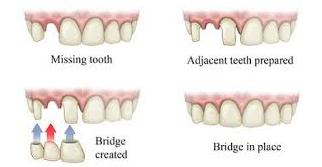Dental Bridges
If you have a missing tooth or a group of adjacent missing teeth, dental bridges can help conceal, fix, and fill in the empty gap with false teeth. Dental bridges can replace one single tooth or multiple teeth and are made up of two main parts: the pontic and the crown. The pontic is the actual false tooth or set of false teeth that will take place of the missing tooth. The crown or crowns — depending on your dental needs — are located to the left and right of the false tooth.

Dental bridges work by attaching the crowns of the dental bridge to the teeth that are directly beside/adjacent to the gap. These neighboring teeth are known as abutment teeth and provide support for your new dental bridge. Depending on your dental needs, your doctor will either recommend a removable dental bridge or a fixed/permanent dental bridge, which can be made of different materials such as porcelain, ceramic, gold, or metal alloy.
There are various types of dental bridges available, which include:
- Traditional dental bridges
- Cantilever dental bridges
- Maryland bonded dental bridges
- Implant-supported bridges
- Dental bridges can help:
- Provide tooth replacement
- Improve the appearance and health of your smile
- Maintain bone structures of the face
- Prevent surrounding teeth from shifting out of position
- Correct issues affecting your bite
- Reduce the risk of temporomandibular joint disorder
Dental bridges come in a variety of materials:
1- All-ceramic bridge
These are the most attractive and natural-looking, but it’s not as strong as the others. It’s the best cosmetic choice for front teeth.
2- Porcelain fused to metal
These are tooth-colored and stronger than all-ceramic bridges because it has a metal core. However, it isn’t as natural-looking.
